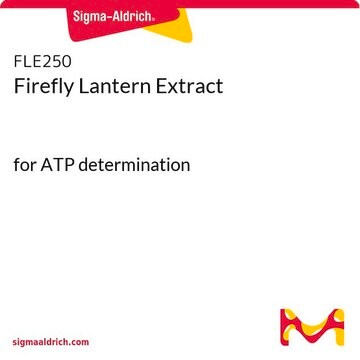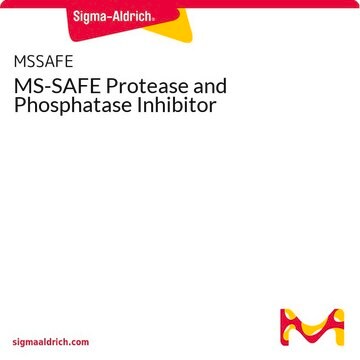Recommended Products
biological source
insect (firefly)
Quality Level
form
solid
packaging
pkg of 100 mg
technique(s)
toxicology assay: suitable
storage temp.
−20°C
Related Categories
Application
Fireflies have been used in several studies of bioluminescence. In particular they may be used in assays to determine toxicity pathways because bioluminescence can quantitatively measure a wide range of biological activities.
Physical form
Each vial contains soluble extract from 100 mg of dried lanterns. After reconstituting with 5 mL of water, the solution will contain 50 mM potassium phosphate, pH 7.4, and 20 mM MgSO4
Storage Class Code
13 - Non Combustible Solids
WGK
WGK 3
Flash Point(F)
Not applicable
Flash Point(C)
Not applicable
Certificates of Analysis (COA)
Search for Certificates of Analysis (COA) by entering the products Lot/Batch Number. Lot and Batch Numbers can be found on a product’s label following the words ‘Lot’ or ‘Batch’.
Already Own This Product?
Find documentation for the products that you have recently purchased in the Document Library.
Tamara N Kirillova et al.
Analytical and bioanalytical chemistry, 400(2), 343-351 (2011-02-22)
The paper investigates an application of luminescent bioassays to monitor the toxicity of organic halides. Effects of xanthene dyes (fluorescein, eosin Y, and erythrosin B), used as model compounds, on bioluminescent reactions of firefly Luciola mingrelica, marine bacteria Photobacterium leiognathi
Tamara N Kirillova et al.
Analytical and bioanalytical chemistry, 387(6), 2009-2016 (2007-01-24)
Bioluminescent reactions of luminous organisms are excellent models for studying the effects of heavy atoms on enzymatic processes. The effects of potassium halides with halide anions of different atomic weight were compared in bioluminescent reactions of the firefly (Luciola mingrelica)
Our team of scientists has experience in all areas of research including Life Science, Material Science, Chemical Synthesis, Chromatography, Analytical and many others.
Contact Technical Service






